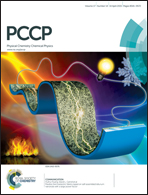Accurate calculation of 31P NMR chemical shifts in polyoxometalates
Abstract
We search for the best density functional theory strategy for the determination of 31P nuclear magnetic resonance (NMR) chemical shifts, δ(31P), in polyoxometalates. Among the variables governing the quality of the quantum modelling, we tackle herein the influence of the functional and the basis set. The spin–orbit and solvent effects were routinely included. To do so we analysed the family of structures α-[P2W18−xMxO62]n− with M = MoVI, VV or NbV; [P2W17O62(M′R)]n− with M′ = SnIV, GeIV and RuII and [PW12−xMxO40]n− with M = PdIV, NbV and TiIV. The main results suggest that, to date, the best procedure for the accurate calculation of δ(31P) in polyoxometalates is the combination of TZP/PBE//TZ2P/OPBE (for NMR//optimization step). The hybrid functionals (PBE0, B3LYP) tested herein were applied to the NMR step, besides being more CPU-consuming, do not outperform pure GGA functionals. Although previous studies on 183W NMR suggested that the use of very large basis sets like QZ4P were needed for geometry optimization, the present results indicate that TZ2P suffices if the functional is optimal. Moreover, scaling corrections were applied to the results providing low mean absolute errors below 1 ppm for δ(31P), which is a step forward in order to confirm or predict chemical shifts in polyoxometalates. Finally, via a simplified molecular model, we establish how the small variations in δ(31P) arise from energy changes in the occupied and virtual orbitals of the PO4 group.


 Please wait while we load your content...
Please wait while we load your content...